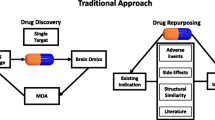You have full access to this open access chapter, Download chapter PDF
Similar content being viewed by others
1 Correction to: © Springer International Publishing AG 2018 Handbook of Experimental Pharmacology, https://doi.org/10.1007/164_2018_101
Figure 1 was published incorrectly in this chapter. The original chapter was corrected. The correct Figure 1 is
Simplified diagram of transcriptional pathways and targets for intervention for alcohol use disorder (AUD) treatment. (a) The cAMP-responsive element binding protein (CREB) pathway. Adenylyl cyclase (AC) produces cAMP from AMP, activating protein kinase A (PKA). CREB is phosphorylated (pCREB) by several kinases, one of which is PKA. Once phosphorylated, CREB translocates to the nucleus and binds to cAMP-responsive elements (CRE) in the DNA to activate transcription of genes associated with AUD such as Bdnf and Npy. One method to activate CREB is to use compounds that inhibit the phosphodiesterases (PDEs) that hydrolyze cAMP, thus increasing cAMP levels and activating PKA. PDE inhibitors reduce alcohol consumption in animal models of AUD. (b) The peroxisome proliferator-activated receptor (PPAR) signaling pathway. PPARs are activated by their endogenous ligands, fatty acids (FA), or by synthetic agonists such as the thiazolidinediones and fibrates. Upon ligand binding, PPARs translocate to the nucleus and interact with retinoid X receptor (RXR) at peroxisome proliferator response elements (PPREs) to regulate gene transcription. PPAR agonists reduce alcohol consumption in animal models of AUD. (c) The nuclear factor kappa-light-chain-enhancer of activated B cells (NF-κB) pathway. NF-κB exists as a dimer of different subunits and is complexed with an inhibitory molecule, inhibitor κB (IκB) in the cytosol. Activation of various receptors leads to activation of IκB kinase (IKKβ) and phosphorylation of IκB. This event targets IκB for degradation, releasing NF-κB for translocation to the nucleus to regulate gene expression at κB elements. IKKβ inhibitors reduce alcohol consumption in mice. (d) Glucocorticoid receptor (GR) pathway. GR is held in the cytosol by chaperone proteins. Once bound to its ligand, cortisol (in humans/nonhuman primates) or corticosterone (in rodents) (CORT), GR translocates to the nucleus and binds to glucocorticoid response elements (GREs) to regulate gene transcription. The GR antagonist mifepristone has shown efficacy in reducing alcohol consumption in rodents and humans
Author information
Authors and Affiliations
Corresponding author
Editor information
Editors and Affiliations
Rights and permissions
Copyright information
© 2018 Springer Nature Switzerland AG
About this chapter
Cite this chapter
Savarese, A.M., Lasek, A.W. (2018). Correction to: Transcriptional Regulators as Targets for Alcohol Pharmacotherapies. In: Grant, K., Lovinger, D. (eds) The Neuropharmacology of Alcohol . Handbook of Experimental Pharmacology, vol 248. Springer, Cham. https://doi.org/10.1007/164_2018_194
Download citation
DOI: https://doi.org/10.1007/164_2018_194
Published:
Publisher Name: Springer, Cham
Print ISBN: 978-3-319-96522-2
Online ISBN: 978-3-319-96523-9
eBook Packages: Biomedical and Life SciencesBiomedical and Life Sciences (R0)





